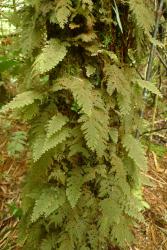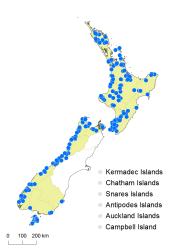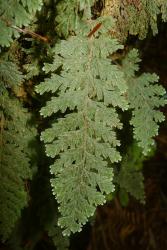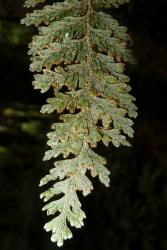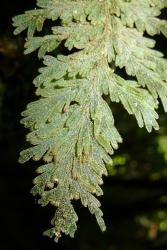- ≡ Hymenophyllum franklinianum Colenso, Tasmanian J. Nat. Sci. 2: 183 (1845)
- ≡ Sphaerocionium frankliniae (Colenso) K.Iwats., J. Fac. Sci. Univ. Tokyo, Sect. 3, Bot. 13: 213 (1982)
- = Hymenophyllum aeruginosum var. franklinianum Hook., Sp. Fil. 1, 94 (1844)
Usually epiphytic ferns, rarely terrestrial or rupestral. Rhizomes long-creeping, 0.2–0.4 mm diameter, bearing unbranched pale red-brown hairs up to 3 mm long, densely clustered at bases of stipes, more evenly distributed elsewhere. Fronds 40–295 mm long. Stipes 10–80 mm long, red-brown, not winged, bearing abundant tawny or red-brown stellate hairs. Laminae 3-pinnatifid or rarely 4-pinnatifid, narrowly ovate or narrowly elliptic or ovate or elliptic, 25–230 mm long, 15–78 mm wide, olive-green, membranous, densely covered in tawny or rusty brown stellate hairs, especially on margins and costae. Rachises narrowly winged at least in distal half, red-brown, densely covered in tawny or rusty brown stellate hairs. Primary pinnae in 5–30 pairs, scarcely overlapping or sometimes overlapping, winged throughout, all adnate or surcurrent; distal portion of primary pinnae straight or slightly incurved acroscopically; distal primary pinnae narrowly ovate or ovate, proximal primary pinnae ovate to narrowly ovate; the longest primary pinnae at or below the middle, 10–60 mm long, 5–23 mm wide, but individual pinnae sometimes greatly extended. Secondary pinnae arising both acroscopically and basiscopically, scarcely overlapping, winged throughout, adnate; elliptic on distal primary pinnae, ovate or elliptic on proximal primary pinnae; the longest secondary pinnae 3–20 mm long, 2–7 mm wide. Ultimate lamina segments oblong, up to 3 mm long, 0.7–1.6 mm wide; apices obtuse; margins entire, lacking a distinct border; distal segments on primary pinnae narrowly divergent. Sori terminating ultimate segments throughout pinnae, solitary, many on each primary pinna, immersed in lamina; indusia bivalvate; indusial flaps broadly elliptic or broader than long, 0.5–0.75 mm long, apices obtuse, margins entire, densely hairy on outer surfaces and margins; receptacles included within indusial flaps or slightly exserted.
Hymenophyllum frankliniae is immediately recognisable by the dense covering of tawny or rusty brown stellate hairs throughout the olive-green fronds. The only other New Zealand filmy ferns with branched hairs are H. lyallii, which has a light green flabellate frond with minute teeth and bifurcate hairs on the margins, and H. malingii, which has stellate grey hairs on the adaxial lamina surface, rusty brown hairs on the abaxial surface, and ultimate segments that are almost round in cross-section.
North Island: Northland, Auckland, Volcanic Plateau, Gisborne, Taranaki, Southern North Island.
South Island: Western Nelson, Sounds-Nelson, Westland, Otago, Southland, Fiordland.
Stewart Island.
Altitudinal range: 15–925 m.
Hymenophyllum frankliniae occurs in lowland and montane areas throughout the North Island from the Maungataniwha Range southwards. It ranges from 70 m along the Whanganui River to 925 m in the Kaitake Range, Taranaki. In the South Island it is confined to lowland areas from the Marlborough Sounds to north-west Nelson, and along the west coast to Fiordland and Southland. It is absent from Marlborough, Canterbury and much of Otago and inland Southland. It is recorded on the east coast only from the Catlins district and Dunedin. It occurs from near sea level to 450 m in the Tākaka River gorge.
Occurs in wet kauri, podocarp, beech and broadleaved forest, most commonly as an epiphyte but also on rotten logs and stumps, and on wet rocks, bluffs or banks. It grows frequently on trunks of Dicksonia squarrosa and Cyathea smithii, but has also been recorded on C. medullaris, C. dealbata and Prumnopitys taxifolia.
n = 36 (Brownlie 1958).
Colenso (1843) first described this species as Hymenophyllum frankliniae, using the genitive form for the epithet. However, he later re-described it as H. franklinianum (Colenso 1845) using the adjectival form for the epithet. The name commemorates Lady Franklin, wife of Sir John Franklin, the then Governor of Tasmania, but since she did not actually collect the species and Colenso was merely commemorating her patronage, the adjectival form was considered more appropriate. The later name was subsequently cited in all subsequent New Zealand Floras, and the earlier name only mentioned again in the Supplementary Notes to Allan’s Flora (Allan 1961). However, the name H. frankliniae was published first, is correctly formed and cannot be considered an orthographic error to be corrected; it is therefore the correct name for this species when treated in Hymenophyllum. In his later description of H. franklinianum, Colenso (1845) cites H. frankliniae in synonymy. Hence H. franklinianum was nomenclaturally superfluous when published because the name that should have been used was cited in synonymy (Art. 52.1, 52.2e). It is best treated as a nomenclatural synonym of H. frankliniae based on the same type.
The issue was further complicated by Hooker (1844–1846) who published the name H. aeruginosum var. franklinianum based on Colenso 272 sent to him as "Hymenophyllum franklinianum n.sp." by Colenso in a letter dated 1 September 1842 (St. George 2009). The publication of this name postdates Colenso's H. frankliniae of 1843, but predates his H. franklinianum of 1845. It must therefore be treated as a separate basionym with a different type.
The basionyms Hymenophyllum aeruginosum Carmich., H. subtilissimum Kunze and H. ferrugineum Colla, and combinations based on them, have been widely misapplied to the species in New Zealand (Allan 1961; Brownsey et al. 1985; Brownsey & Smith-Dodsworth 2000; see Ebihara et al. 2010). Morphological and molecular data indicate that H. ferrugineum and H. frankliniae are distinct species distributed in South America and New Zealand respectively (Iwatsuki 1982; Ebihara et al. 2004).



